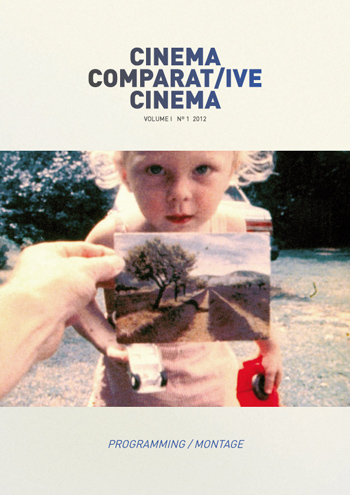R. Bruce Elder: Harmony and Dissent: Film and Avant-garde Art Movements in the Early Twentieth Century (2008)
Filed under book | Tags: · abstract cinema, art history, avant-garde, cinema, colour, constructivism, dissent, experimental film, film, film history, film theory, marxism, modernism, music, occultism, productivism, revolution, suprematism, symbolism, theology

“R. Bruce Elder argues that the authors of many of the manifestoes that announced in such lively ways the appearance of yet another artistic movement shared a common aspiration: they proposed to reformulate the visual, literary, and performing arts so that they might take on attributes of the cinema. The cinema, Elder argues, became, in the early decades of the twentieth century, a pivotal artistic force around which a remarkable variety and number of aesthetic forms took shape.
To demonstrate this, Elder begins with a wide-ranging discussion that opens up some broad topics concerning modernity’s cognitive (and perceptual) regime, with a view to establishing that a crisis within that regime engendered some peculiar, and highly questionable, epistemological beliefs and enthusiasms. Through this discussion, Elder advances the startling claim that a crisis of cognition precipitated by modernity engendered, by way of response, a peculiar sort of “pneumatic (spiritual) epistemology.” Elder then shows that early ideas of the cinema were strongly influenced by this pneumatic epistemology and uses this conception of the cinema to explain its pivotal role in shaping two key moments in early-twentieth-century art: the quest to bring forth a pure, “objectless” (non-representational) art and Russian Suprematism, Constructivism, and Productivism.”
Publisher Wilfrid Laurier University Press, Waterloo, 2008
ISBN 1554580285, 9781554580286
480 pages
Review: David Sterritt (Quarterly Review of Film and Video, 2011).
PDF (updated on 2019-12-14)
Comments (7)Cinema Comparat/ive Cinema journal, Nos. 1–2: Programming/Montage & Forms in Revolution (2012–13) [EN/ES/CAT]
Filed under journal | Tags: · cinema, film, film criticism, film history, film theory


Cinema Comparat/ive Cinema is a biannual publication founded in 2012. It focuses on comparative cinema and the reception and interpretation of film in different social and political contexts. Each issue investigates the conceptual and formal relationships between films, material processes and production and exhibition practices, the history of ideas and film criticism.
Cinema Comparat/ive Cinema addresses an original area of research, developing a series of methodologies for a comparative study of cinema. With this aim, it also explores the relationship between cinema and comparative literature as well as other contemporary arts such as painting, photography, music or dance, and audio-visual media.
Edited by Colectivo de Investigación Estética de los Medios Audiovisuales (CINEMA) at the Universitat Pompeu Fabra (UPF), Barcelona
Creative Commons Attribution-NonCommercial-ShareAlike 3.0 Unported License
ISSN 2014-8933
Volume 1, Nº 1, «Programming/Montage», 2012
PDF (English), Spanish, Catalan.
View online (HTML articles, English), Spanish, Catalan.
Volume 1, Nº 2, «Forms in revolution», 2013
PDF (English), Spanish, Catalan.
View online (HTML articles, English), Spanish, Catalan.
Rosemari Elizabeth Baker: Shklovsky in the Cinema, 1926-1932 (2010)
Filed under thesis | Tags: · art history, cinema, film, film history, literary theory, literature
“The following research project is grounded in the interrelated contexts of the Russian intelligentsia’s ambivalent engagement with post-revolutionary culture and cinema’s rise as an artistic medium and instrument of Russian cultural development. By examining Viktor Shklovsky’s earliest activities in the Soviet film industry, this project will explore how narrative, aesthetic, and ideological programmes were repeatedly and variously moulded, undermined, and complicated by the twentieth-century Russian avant-garde interest in dissolving creative boundaries between the domains of the ‘internal’ (embracing private, individual, and domestic concerns) and ‘external’ (their public, communal, and social counterparts) in a bid ‘to turn space outwards’ (vyvorachivat´ prostranstvo vovne). These critical enquiries will lend themselves to an investigation of how the behaviours of Shklovsky, his colleagues, and his artistic creations were affected by internal and/or external loci of control and how these activities were reconciled (if at all) in a society where the relationship between freedom and necessity was in a constant state of fluctuation.
This research aims not simply to establish the extent and significance of Shklovsky’s influence on cinema as an individual, but rather to utilise his personal narrative for an assessment of the levels of interaction between theory and practice and between the verbal and the visual as integral to the intelligentsia movement. The project will investigate the part that Shklovsky played in conceptualising the boundaries, exchanges, and conflicts that arose between different artistic media and the critical institutions that developed around them, before considering how these relations changed as Soviet culture entered and emerged from the period of Cultural Revolution. In addition, an exploration of the effects of personal and professional tensions between different ideological groups will not only develop a better understanding of Shklovsky’s role in the cinema as theorist, critic, polemicist, screenwriter, and ‘creative administrator’, but will also help to establish the similarities and/or disparities between his film-works and contemporary cultural experience.” (Abstract)
Master Thesis
Faculty of Arts and Humanities, Durham University
209 pages

